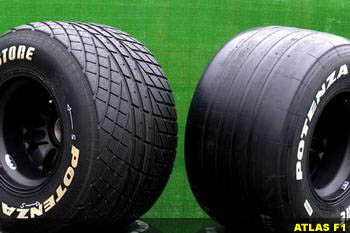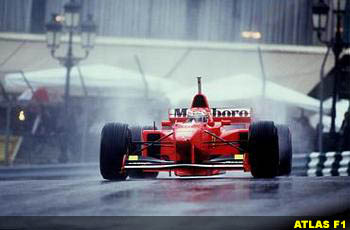|
| |||
 |
Taking the Lid Off F1 Formula One Technical Analysis | ||
| by Will Gray, England | |||
|
Atlas F1 presents a series of articles by certified engineer Will Gray, that investigates in greater depth all the technical areas involved in design, development, and construction of a Formula One car.
You can't re-invent the wheel but you can re-invent the tyre, and the engineers from Bridgestone do that constantly - the simple looking tyre is, in fact, a very complex component. No matter how much grip the rule makers take away from the tyres, like the car designers, the tyre engineers soon get that back.
In tyre design, there are three main considerations - the profile and size, the tread, and the compound. As explained in the previous section, the contact patch is all important, and the size of this determines the grip available - the bigger the contact patch, the bigger the grip. However, the amount of useful cornering grip is determined by the aspect ratio of the tyre. This is the length of the contact patch (in forward direction) divided by its width. With the famed F1 slicks of a few years ago, the aspect ratio was low as the tyres were extremely wide. A low aspect ratio tyre will deform less than one with a higher value, and so will create less heat (as some deformation energy turns to heat).
The tread pattern required depends on the conditions. In Formula One, there are 'wets' and there are 'grooved tyres'. The slicks which became synonymous with F1 have been laid to rest - for now! It is an oft made mistake thinking that for grip a tyre needs tread - this comes from choosing tyres for our road cars, which must have the ability to cope with all weather situations. In fact, in the dry, it is the rubbery compound sticking to the road which gives us the grip, so tread is a no no - the larger the area of rubber in contact with the track the better. This is why the 'grooved' tyres have been introduced. In an aim to decrease cornering speeds by decreasing the level of grip available, the powers that be decided to reduce the contact patch area by insisting on grooves - thus keeping the tyre wide to retain the speed-reducing drag of wide tyres, whilst still reducing the grip.
The last major area of tyre design mentioned was the tyre compound. We hear of soft and hard compounds, but what exactly are they, and why is the choice between them so important? Well, the soft compound will deteriorate faster than the hard through simple wear, but because it is soft, it is more sticky, and will provide more grip in the short-term. The Formula One rules currently demand the choice of tyre (except in circumstances of rain) be made before qualifying on Saturday. Once this choice is made, only the type of tyre specified may be run - choose soft for a top qualifying time, and if Sunday turns out to be a scorcher, you're in and out of the pits all afternoon!
Once the tyre is designed, there are still areas which affect its performance. Normally, the grip level increases as the pressure of the air inside is raised. However, the large F1 tyres are designed to have their optimum profile at a certain level of inflation, and for that reason there are limits to how the alteration of tyre pressure affects performance.
Talking of temperatures, this is another operating consideration. In doing work on the race track - for that is what the tyre's main job is, heat will be developed to balance energy losses. A well designed tyre will heat to 'racing temperature', then level off. When operating below this racing temperature, the tyre will give the driver less grip than he normally gets, and can result in unfortunate and embarrassing rotations on the first lap out of the pits! When operating above it (towards the end of the stint, when the tyre has had to work around numerous corners, and has therefore constantly developed heat), the rubber compound will be slowly destroyed, and may blister. The grip available will reduce because the rubber is not working ideally, and it's time for a new set of boots.
This is also seen on a drying track when running with wets. The compound is harder, to cope with the cooler operating conditions on a wet track, but when the track begins to dry, the compound is too hard, and the rubber will deteriorate - this is why cars often dart off line in search for water in a wet race.
Tyres just add another variable to the ever growing list on a race engineer's clipboard, and in the dry, the 'Stick or Stay' compromise (soft or hard) is one of the hardest and most crucial decisions for the race engineer on qualifying day, and on which could shape the whole race weekend.
Previous Parts in this Series: Parts 1 & 2 | Part 3 | Part 4A | Part 4B | Part 4C | Part 5A
|
| Will Gray | © 2000 Kaizar.Com, Incorporated. |
| Send comments to: gray@atlasf1.com | Terms & Conditions |
 This means that the largest, most useful contact patch is obtained by having a wide, large diameter tyre. However, in terms of open wheeled racecar aerodynamics, the larger the tyre, the more drag it creates. Therefore, any change in tyre profile and size requires a compromise between the addition of good mechanical grip, and the detrimental effect of additional drag. This was seen in 1997, when Bridgestone brought out a wider front tyre, giving more grip for what was seen as an acceptable level of increased drag.
This means that the largest, most useful contact patch is obtained by having a wide, large diameter tyre. However, in terms of open wheeled racecar aerodynamics, the larger the tyre, the more drag it creates. Therefore, any change in tyre profile and size requires a compromise between the addition of good mechanical grip, and the detrimental effect of additional drag. This was seen in 1997, when Bridgestone brought out a wider front tyre, giving more grip for what was seen as an acceptable level of increased drag.
 With a wet track, using slicks or even straight grooved tyres makes the track like an ice rink. What is required here is a pattern of grooves so that the water in front of the tyre is channeled away as the tyre rolls over it. This is why all road cars have a large amount of tread pattern. The water is channeled outwards from in front of the contact patch as the tyre rolls, preventing the unpleasant situation of aquaplaning. This occurs when there is too much standing water for even the 'wets' to cope with, and results in the tyre turned to take a corner having fully sliding, and no elastic friction, and the car going straight on.
With a wet track, using slicks or even straight grooved tyres makes the track like an ice rink. What is required here is a pattern of grooves so that the water in front of the tyre is channeled away as the tyre rolls over it. This is why all road cars have a large amount of tread pattern. The water is channeled outwards from in front of the contact patch as the tyre rolls, preventing the unpleasant situation of aquaplaning. This occurs when there is too much standing water for even the 'wets' to cope with, and results in the tyre turned to take a corner having fully sliding, and no elastic friction, and the car going straight on.
 Also, of course, racing tyres operate at hot temperatures. As air expands with increasing temperature, it is important to predict how the pressures vary over the temperature range so that a tyre can be set 'cold', and the heat will expand the air to the required 'hot pressure'. This is done by constant monitoring of the tyre pressures and temperatures, as well as being part of the reason for the use of tyre warmers, which pre-heat the tyres close to racing temperatures.
Also, of course, racing tyres operate at hot temperatures. As air expands with increasing temperature, it is important to predict how the pressures vary over the temperature range so that a tyre can be set 'cold', and the heat will expand the air to the required 'hot pressure'. This is done by constant monitoring of the tyre pressures and temperatures, as well as being part of the reason for the use of tyre warmers, which pre-heat the tyres close to racing temperatures.